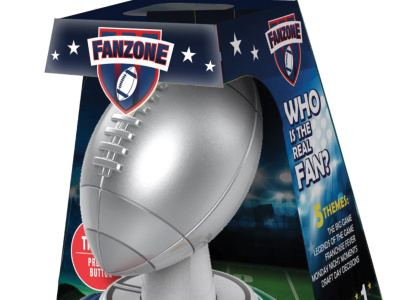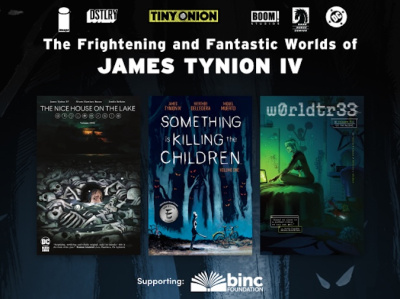We recently conducted our annual interview with Marvel publisher Dan Buckley about the state of the comics business and Marvel's place in it. In Part 1, we talk about the over-all market conditions for comics and graphic novels in comic stores, bookstores, mass merchants, and newsstand outlets. In Part 2, we discuss the way Marvel approaches its mass market outlets as ways to reach new consumers, the relationship between movies and graphic novel sales, and Marvel's graphic novel share and investment in inventory. In Part 3, we talk about whether videogame licenses help or hurt comic sales and the risks and rewards of variant covers and reprints. And in Part 4, we talked whether Marvel would ever license its comics (like it does toy manufacturing), whether comic-based movies are a bubble, how Marvel is approaching the female young adult market, and the challenges and opportunities for the coming year.
What's your perspective on the state of the market, 2005 versus 2004, for comics and graphic novels over-all.
It's a little bit more competitive from a Marvel and DC standpoint. From a market dynamic in the direct market [standpoint], it's the Big Two and other publishers going on right now. From a marketing and product offering [standpoint], it's been a good year for direct market retailers. Between House of M and the Infinity Crisis there's a lot of product for them to sell. We're probably doing a little bit more of an event where things are happening in a book, and DC's doing much more of a major crossover connected story lattice. It will be interesting to see how that affects the market, but it's very good; sales are up. It's been a good year, especially for DC and Marvel.
From the standpoint of over-all growth, it's exciting what's going on with the bookstore business. We've had a very good year (not just in bookstores but in the direct market). We have a lot more offerings in our classic category, and our Ultimates line continues to do very well for us in both markets. We've also seen quite a bit of growth with our digest program in various distribution networks. Barnes and Borders are doing very well for us with the digest program, all ages, and some of our YA (Young Adult, ed.), which I would put in the Runaways vein. We're experimenting with different IP, from Arana to Machine Teen to Spellbinders. We're generating some excitement. Runaways is the lead of that stuff. Target is continuing to do well. The most exciting thing going on for us is that the all ages line with Marvel Adventures is sticking. Our initial response to the mass market relaunch into the newsstand business is going pretty well (fingers crossed, we still have two or three months to see how it's going).
This year compared to last year the direct market's experiencing some growth. That's nice to see especially considering all the years it wasn't growing. We're experiencing some opening of avenues in new distribution channels, therefore, getting new readers, and getting people excited about what we're doing between bookstores, convenience stores and drug stores. We weren't there last year. The digest programs and the all ages programs have really helped with that.
Going to bookstores, last year we talked about the growth in pockets for graphic novels and whether that was adequate to support the number of titles that publishers were asking bookstores to field. Are you feeling any more pressure on the available space there in the graphic novel departments?
We aren't really experiencing any pushback from the offering that we're giving them. We're getting the space necessary. Both of the big players have been very supportive of the category, and they're not saying, 'Less! Don't offer me as much.' Do they go into to everything wholeheartedly? No, but they take a little of everything we do with the exception of things we don't offer them, that being the mass merch hardcover program. We are getting pushed back that way.
We might disagree on how deep they should go on an order and where something should be merchandised, where you should rack something. But those are things that we're working through as we try to expand the category from a Marvel perspective. The best example is that we are doing digest-formatted books because that's where we think the manga reader is. I'm know I'm not making manga, I'm not professing that, but we do think we have some products that the manga reader or demographic might be comfortable with. Runaways is the flagship of that. We might go back and forth, but we're not getting pushed back and told, 'Don't make the product for me.'
The dynamic is slightly different for DC and us--that plethora of titles wasn't coming from us. It was coming from the manga publishers and the fact that so many publishers are jumping into that category. The dynamic has settled down a little bit. From what I've seen in the stores, I think the category's safe. I think the category's solid and it's growing and the bookstores are going to support it. Like I said last year, we've probably got a couple more years before we finally figure out what the product mix will be in graphic fiction. The movies doing well helps Marvel and DC tremendously. Having a familiar IP does take you a long way. They seem to be accepting the things we present to them. The classic stuff they don't go as deep on, but Ultimates does really well there, and we've been very happy with the digest program.
Are you getting digests into any mass merchant channels?
We haven't aggressively pushed that yet. Scholastic has taken some of the digests into their book fair programs and into various distribution paths. Not the whole line, obviously, though they're taking pretty good orders, and putting Spider-Man in front of them, Spider-Girl. Every year of trust they build with us, the better opportunity we have to put another title in. We are doing some other distribution paths, we are talking to other people to see if they would be interested in taking the digest format. But, you know, slow and steady.
You mentioned convenience stores. Obviously that's a very large number of outlets, maybe the biggest expansion in outlets for comics in a long time. Did you say that it was really too early to tell how that's going?
Our initial results look pretty good. But as you well know, with the newsstand business and its returnable nature, the final count isn't until the final count. We'll have a much better feel for what the first six books did in the fourth quarter, but the initial feedback has been very good. The retailers are happy and we're happy. It's very exciting to get this product out in twenty thousand storefronts.
What titles did you put out there?
We led with Marvel Adventures, a $1.99 launch book, Fantastic Four Zero. That was on sale first week in June. We went very aggressively across the board with it, into 7-11s, Blockbusters, Walgreens, a variety of different places. And then the core product mix is six titles that are $3.99 apiece, that have two comic book stories in each of them. They're double-sized books, sixty-four pages. They're flip-book formats so there are two covers for each book. The flagship title is Marvel Adventures; it's all ages titles--one side is Fantastic Four, the other side is Spider-Man. It has four to five pages of material that promotes to all ages and focuses on them. We feel very comfortable with that product everywhere. The other five books are Marvel Heroes, which is New Avengers and Captain America; Marvel Select, with Astonishing X-Men and New X-Men; Marvel Tales with Amazing Spider-Man and Arana; then we have Ultimate Tales, which is Ultimate Spider-Man; and Ultimate Marvel, which is Ultimate X-Men and Ultimate Fantastic Four. In those five, we made sure that we have a lot of house ads, in-house promotional stuff, because we remember picking up books where you feel like you're a member of a club. We're trying to speak more directly to consumers. Plus we have a couple of extra pages to play with because they're 64 pages, so we make sure we're communicating the broad spectrum and line that's out there.
When we first ran the story on the newsstand launch, one comment we got was that Marvel should run stand-alone stories rather than continuing stores. It sounds like in the titles you listed there's probably some that tend a little more way and some the other. Your thoughts?
Marvel Adventures is very much focused on stand-alone stories. There will be a stand-alone FF story and a stand-alone Spider-Man story. That's not to say they might not develop an over-arching arc someday down the road; I'm not discounting any storytelling. It's an all-ages read; we want people to think they got something out of it immediately. Hopefully it's like their first experience of reading a comic book. I think it's much more essential for that book.







